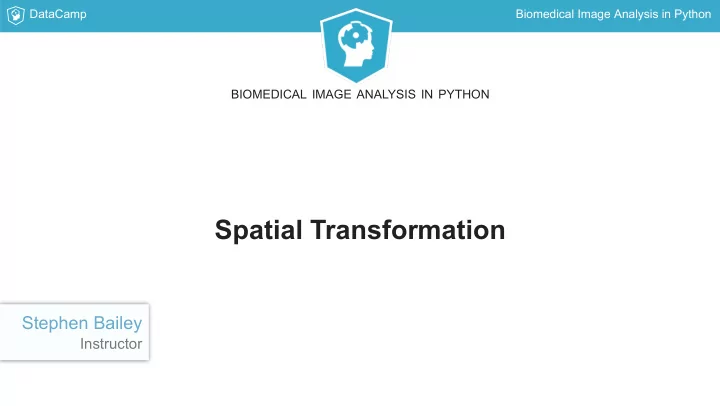

DataCamp Biomedical Image Analysis in Python BIOMEDICAL IMAGE ANALYSIS IN PYTHON Spatial Transformation Stephen Bailey Instructor
DataCamp Biomedical Image Analysis in Python OASIS Database
DataCamp Biomedical Image Analysis in Python Significant variability
DataCamp Biomedical Image Analysis in Python Registration Align images to template Minimize spatial variability Templates: may represent multiple subjects may be an "average" image Entails many spatial transformations
DataCamp Biomedical Image Analysis in Python Affine transformations preserve points, lines, and planes
DataCamp Biomedical Image Analysis in Python Translation import imageio import scipy.ndimage as ndi im=imageio.imread('OAS1036-2d.dcm') im.shape (256, 256) com = ndi.center_of_mass(im) d0 = 128 - com[0] d1 = 128 - com[1] xfm = ndi.shift(im, shift=[d0, d1])
DataCamp Biomedical Image Analysis in Python Rotation ndi.rotate(im, angle=25, axes=(0,1))
DataCamp Biomedical Image Analysis in Python Image rotation xfm = ndi.rotate(im, angle=25) xfm = ndi.rotate(im, angle=25, reshape=False) xfm.shape xfm.shape (297, 297) (256, 256)
DataCamp Biomedical Image Analysis in Python Transformation matrix Transformation matrix : applied to one image for registration. Elements of the matrix encode "instructions" for different affine transformations.
DataCamp Biomedical Image Analysis in Python Applying a transformation matrix # Identity matrix # Translate and rescale mat = [[1, 0, 0], mat = [[0.8, 0, -20], [0, 1, 0], [0, 0.8, -10], [0, 0, 1]] [0, 0, 1]] xfm = ndi.affine_transform(im, mat) xfm = ndi.affine_transform(im, mat)
DataCamp Biomedical Image Analysis in Python BIOMEDICAL IMAGE ANALYSIS IN PYTHON Let's practice!
DataCamp Biomedical Image Analysis in Python BIOMEDICAL IMAGE ANALYSIS IN PYTHON Resampling and Interpolation Stephen Bailey Instructor
DataCamp Biomedical Image Analysis in Python Resampling changes the array shape
DataCamp Biomedical Image Analysis in Python Downsampling vol = imageio.volread('OAS1_0255') vol_dn = ndi.zoom(vol, zoom=0.5) vol.shape vol_dn.shape (256, 256, 256) (128, 128, 128)
DataCamp Biomedical Image Analysis in Python Upsampling vol_up = ndi.zoom(vol, zoom=2) Resampling to a larger grid vol_up.shape (512, 512, 512) Not the same as collecting higher- resolution data Useful for standardizing sampling rates that are unequal
DataCamp Biomedical Image Analysis in Python Interpolation "Stitches together" grid points to Interpolation in 1 Dimension model the space between points.
DataCamp Biomedical Image Analysis in Python Interpolation Interpolation in 1 Dimension "Stitches together" grid points to model the space between points. Nearest-neighbor : uses the closest measured value.
DataCamp Biomedical Image Analysis in Python Interpolation Interpolation in 1 Dimension "Stitches together" grid points to model the space between points. Nearest-neighbor : uses the closest measured value. order = 0 B-spline interpolation : models space between points with spline functions of a specified order. order is between 1 and 5
DataCamp Biomedical Image Analysis in Python Interpolation in 2D im=np.arange(100).reshape([10,10]) zm1=ndi.zoom(im, zoom=10, order=0) zm2=ndi.zoom(im, zoom=10, order=2) zm3=ndi.zoom(im, zoom=10, order=4)
DataCamp Biomedical Image Analysis in Python BIOMEDICAL IMAGE ANALYSIS IN PYTHON Let's practice!
DataCamp Biomedical Image Analysis in Python BIOMEDICAL IMAGE ANALYSIS IN PYTHON Comparing Images Stephen Bailey Instructor
DataCamp Biomedical Image Analysis in Python Comparing images
DataCamp Biomedical Image Analysis in Python Summary metrics Goal: define a metric of similarity between two images. Cost functions produce metrics to be minimized. Objective functions produce metrics to be maximized.
DataCamp Biomedical Image Analysis in Python Mean absolute error import imageio import numpy as np i1=imageio.imread('OAS1035-v1.dcm') i2=imageio.imread('OAS1035-v2.dcm') err = i1 - i2 plt.imshow(err) abs_err = np.abs(err) plt.imshow(abs_err) mae = np.mean(abs_err) mae 29.8570
DataCamp Biomedical Image Analysis in Python Mean absolute error Goal: minimize the cost function # Improve im1 alignment to im2 xfm=ndi.shift(im1, shift=(-8, -8)) xfm=ndi.rotate(xfm, -18, reshape=False) # Calculate cost abs_err = np.abs(im1 - im2) mean_abs_err = np.mean(abs_err) mean_abs_err 13.0376
DataCamp Biomedical Image Analysis in Python Intersection of the Union I ∩ I 1 2 IOU = I ∪ I 1 2 mask1 = im1 > 0 mask2 = im2 > 0 intsxn = mask1 & mask2 plt.imshow(intsxn) union = mask1 | mask2 plt.imshow(union) iou = intsxn.sum() / union.sum() iou 0.68392
DataCamp Biomedical Image Analysis in Python BIOMEDICAL IMAGE ANALYSIS IN PYTHON Let's practice!
DataCamp Biomedical Image Analysis in Python BIOMEDICAL IMAGE ANALYSIS IN PYTHON Normalizing Measurements Stephen Bailey Instructor
DataCamp Biomedical Image Analysis in Python Analysis workflow
DataCamp Biomedical Image Analysis in Python OASIS Population df.shape (400, 5) df.sample(5) age sex alzheimers brain_vol skull_vol ID OAS1_0272 75 F True 851.451 1411.125695 OAS1_0112 69 F False 894.801 1434.146892 OAS1_0213 48 F False 925.859 1412.781004 OAS1_0311 22 F False 980.163 1363.413762 OAS1_0201 85 F False 904.104 1420.631447
DataCamp Biomedical Image Analysis in Python Hypothesis testing
DataCamp Biomedical Image Analysis in Python Hypothesis testing Null hypothesis : two populations' mean brain volumes ( μ , μ ) are equal. m w : μ = μ H null w m : μ ≠ μ H alt w m ¯ − μ X t = s /√ n Implemented in scipy.stats.ttest_ind()
DataCamp Biomedical Image Analysis in Python Hypothesis testing brain_m = df.loc[df.sex == 'M', 'brain_vol'] brain_f = df.loc[df.sex == 'F', 'brain_vol'] from scipy.stats import ttest_ind results = ttest_ind(brain_m, brain_f) results.statistic 10.20986 results.pvalue 5.03913e-22 A large t -statistic and low p -value suggests that there is a significant difference!
DataCamp Biomedical Image Analysis in Python Correlated measurements df[['brain_vol', 'skull_vol']].corr() 'brain_vol' 'skull_vol' 'brain_vol' 1.000 0.736 'skull_vol' 0.736 1.000
DataCamp Biomedical Image Analysis in Python Normalization df['brain_norm'] = df.brain_vol / df.skull_vol brain_norm_m = df.loc[df.sex == 'M', 'brain_norm'] brain_norm_f = df.loc[df.sex == 'F', 'brain_norm'] results = ttest_ind(brain_norm_m, brain_norm_f) results.statistic -0.94011 results.pvalue 0.34769 Size, not gender likely drove original results.
DataCamp Biomedical Image Analysis in Python Many potential confounds in imaging Image acquisition Subject / object Contrast Age Resolution Gender Field of view Pathology Context Data Quality Hospital Format Radiologist Artifacts Equipment
DataCamp Biomedical Image Analysis in Python Congratulations!
DataCamp Biomedical Image Analysis in Python BIOMEDICAL IMAGE ANALYSIS IN PYTHON Good luck!
Recommend
More recommend